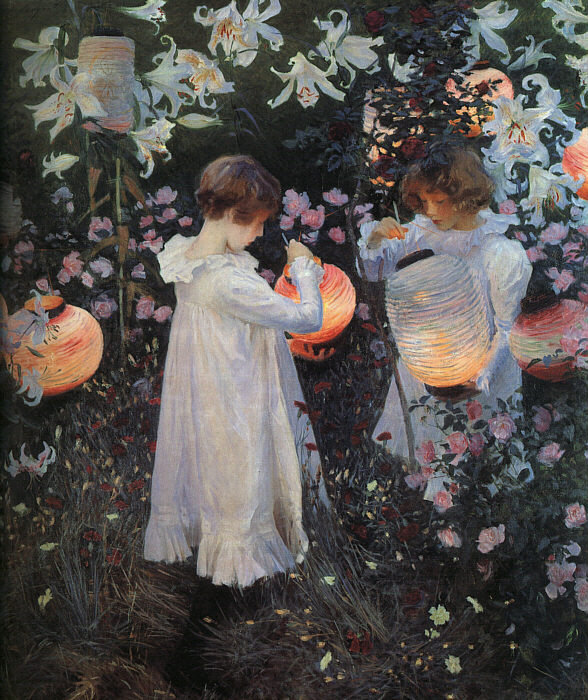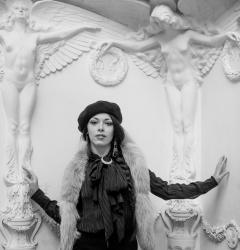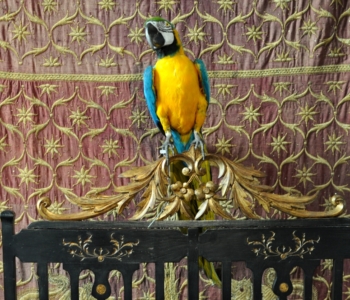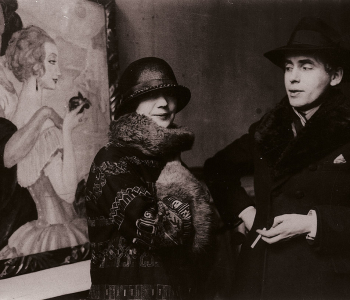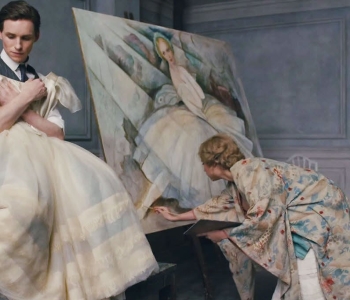
Carnation, Lily, Lily, Rose, John Singer Sargent, 1885-1886
This painting by J. S. Sargent express the mood I’m into for this upcoming month. This painting is so delicate and dreamful, a magical moment, secret and hidden. “I am trying to paint a charming thing I saw the other evening. Two little girls in a garden at twilight lighting paper lanterns among the flowers from rose-tree to rose-tree. I shall be a long time about it if I don’t give up in despair”.
Sargent tried to capture the light of dusk, that specific dusky light one can see just after sunset during summer’s evening. He told Robert Louis Stevenson that he was seeking to capture “a most paradisiac sight [that] makes one rave with pleasure”
source: davesgarden.com

I felt the same atmosphere watching this short film by Joseph Cornell I discovered lately. It’s called “Nymphlight” and was made with Rudolph Burckhardt in 1957. Cornell made two kinds of films in two distinct periods of activity: collage films, made by recombining found materials, and directed films,where he worked with other cinematographers. Nymphlight is one of these.
A young girl in a frilly, old-fashioned gown walks hurriedly through New York’s Bryant Park. She is out of place, like a figure from another era. She has a broken parasol. We see shots of the people in the park and at the end we see a man emptying out the trash barrels who misses the parasol. Actually nothing happens in the film, it’s like watching slice of New York life from the 1950s. Mesmerizing, magical and mystical.
Nymphlight, Joseph Cornell, 1957
(music is not original! you can see the original silent version here)





Coré, Paolo Schmidlin, ceramic version, 2009
Last weekend, while I was visiting the Rome Contemporary Art Fair, I was struck to see this work by the artist Paolo Schmidlin, exposed there by Galleria Benappi. It’s a ceramic sculpture in natural size representing Marchesa Luisa Casati. I already knew the bronze sculpture-portrait by P. Schmidlin permanently exposed at Vittoriale since 2010, of which this one is copy made in ceramic, but it was the first time I saw it for real and it was quite disturbing. It seems you can look the Marchesa straight in the eyes.
 Coré, Paolo Schmidlin, 2009
Coré, Paolo Schmidlin, 2009
The sculpture, made in ceramic and real pearls, is a realistic and evocative lifelike portrait, probably influenced by this painting by Augustus John, but it clearly is more than a simply portrait, it hides a real fascination for this figure. The dress has little medusa heads like the one on the Mario Biazzi’s painting that was also exposed. I found out that Paolo Schmidlin is one of the few contemporary artists to have paid an homage to Luisa Casati.
 Coré, Paolo Schmidlin, bronze version now at Vittoriale
Coré, Paolo Schmidlin, bronze version now at Vittoriale

Ritratto della Marchesa Casati, Mario Biazzi, 1920’s
The ceramic sculpture was next to this painting, a work by italian artist Mario Biazzi and owned by Paolo Shmidlin himself.
 While I was looking for Marchesa Casati’s pictures I found this one, but still I don’t understand if she is really her. Does anyone can help me? By the way yesterday was the death anniversary of Luisa Casati, who died in London the 1st June 1957. As I remembered her birth, I’m remembering her death. All the words in the world can’t express the admiration I have for her.
While I was looking for Marchesa Casati’s pictures I found this one, but still I don’t understand if she is really her. Does anyone can help me? By the way yesterday was the death anniversary of Luisa Casati, who died in London the 1st June 1957. As I remembered her birth, I’m remembering her death. All the words in the world can’t express the admiration I have for her.
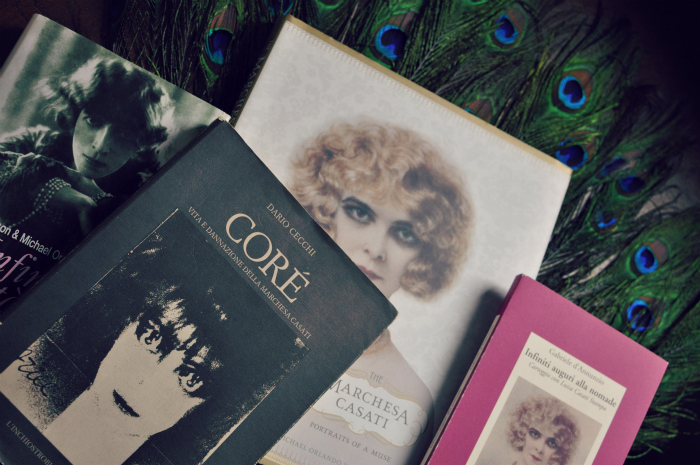 (left to right: “Infinite Variety” and “The Marchesa Casati. Potraits of a muse” both by S. D. Ryersson and M. O. Yaccarino; “Coré. Vita e dannazione della Marchesa Casati” by Dario Cecchi; “Infiniti Auguri alla nomade” curated by Raffaella Castagnola.)
(left to right: “Infinite Variety” and “The Marchesa Casati. Potraits of a muse” both by S. D. Ryersson and M. O. Yaccarino; “Coré. Vita e dannazione della Marchesa Casati” by Dario Cecchi; “Infiniti Auguri alla nomade” curated by Raffaella Castagnola.)
This is my collection of books about the Marchesa. I added two pictures in the post Villa San Michele, showing the Villa during Marchesa’s stay. I also added a new column called Around where I list all the places where my restlessness lead me to since I started this blog.

Démasquée, 1888
It ended not so long ago (6th May) a great exhibition at Musée d’Orsey in Paris dedicated to swedish painter Akseli Gallen-Kallela, such a pity having missed it!

Parisienne, 1888

Aino Myth, Triptych 1891

Ad astra, 1907

The Defense of the Sampo, 1896

Akseli Gallen-Kallela in 1906
 Honestly I’m not so into Mark Ryden art, but his studio is fantastic!
Honestly I’m not so into Mark Ryden art, but his studio is fantastic!
 Tabitha Simmons’ room via TheCoveteur.
Tabitha Simmons’ room via TheCoveteur.
Dolce&Gabbana jacket on the left and a vintage one on the right, both with amazing gold embroidery. What I loved the most is the combination between these jackets and this kind of flower arrangement made out of shells.


These amazing images are just a few examples of the treasures coming from a wonderful website I discovered few days ago: The Public Domain Review.
It’s a free online journal full of marvellous curiosities like classic works of art, music and literature, illustration and abandoned drafts, silent films, old photographs and other fragments and other all out-of-copyright material dig out from the web.
 I’m in love with this skeleton dress by Stolen Girlfriends Club.
I’m in love with this skeleton dress by Stolen Girlfriends Club.

 The blogger Louise Ebel (my favorite fashion blogger) seems to be fascinated by religious iconography. This is just a little detail of her wonderful house. She has a great sense of decoration!
The blogger Louise Ebel (my favorite fashion blogger) seems to be fascinated by religious iconography. This is just a little detail of her wonderful house. She has a great sense of decoration!

Lately I’m very fascinated by Rodarte, a clothing brand founded by two sisters, Kate and Laura Mulleavy, from LA. I found brilliant that they was inspired by Fra Angelico for this capsule collection. It’s been exposed at LACMA, Los Angeles, until February 5 2012.
The collection is inspired by Italian art, specifically the Renaissance frescoes in the monastery of San Marco by Fra Angelico in Florence, Italy, as well as the Baroque sculpture, Ecstasy of Saint Teresa, by Gian Lorenzo Bernini (1598–1680) in Rome.





And here the collection worn by Elle Fanning Elle Fanning by Bill Owens for A Magazine #11


 Kirsten Dunst photographed by David Armstrong wearing the Rodarte F/W 2011 Collection
Kirsten Dunst photographed by David Armstrong wearing the Rodarte F/W 2011 Collection
 And I can’t take my mind off of this old collection Rodarte did for Opening Ceremony last fall.
And I can’t take my mind off of this old collection Rodarte did for Opening Ceremony last fall.






The last resort Chanel collection was inspired by 18th century and was held in Versailles.




We commonly think that today fashion has reached levels of fantasy never conceivable before, but when I found these shoes by the French designer Steven Arpad (1904-1999) I had changed my mind. Aren’t they incredibily modern?
source: retronaut.co



Also Gabriele d’Annunzio had a great fantasy in shoes (shoes belonged to Gabriele d’Annunzio and now at Vittoriale museum).

